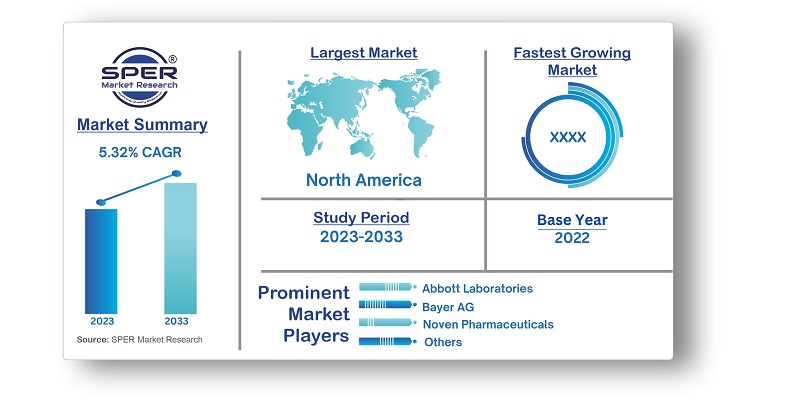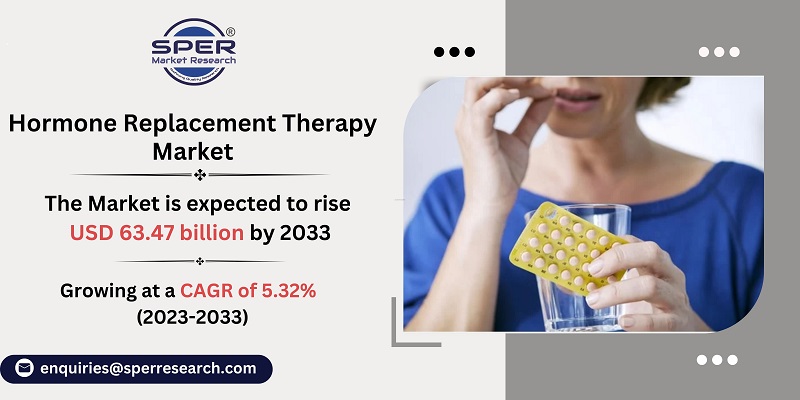
Hormone Replacement Therapy Market Growth, Size, Trends, Revenue, Share and Future Outlook
Hormone Replacement Therapy Market Size- By Therapy Type, By Route of Administration, By Indication, By Distribution Channel, By End Use- Regional Outlook, Competitive Strategies and Segment Forecast to 2033
| Published: Nov-2023 | Report ID: HLCA2370 | Pages: 1 - 234 | Formats*: |
| Category : Healthcare | |||
- 2022: Ascendis Pharma A/S has acquired European Commission approval to sell its medication SKYTROFA for the treatment of growth hormone abnormalities in children and adolescents.
- 2021: Theramex has announced the clearance of Bijuva / Bijuve throughout Europe and the United Kingdom. Bijuva is a body-identical hormone therapy (HRT) treatment for oestrogen insufficiency symptoms in postmenopausal women with an intact uterus and at least 12 months since last menstruation that contains oestradiol and progesterone in a single daily oral capsule.
- 2020: The US Food and Drug Administration approved Myovant Sciences' Orgovyx (relugolix), an orally administered treatment that works by preventing the pituitary gland from producing luteinizing hormone and follicle-stimulating hormone, resulting in a decrease in the amount of testosterone produced by the testicles. This helps to treat adult patients with advanced prostate cancer.


| Report Metric | Details |
| Market size available for years | 2019-2033 |
| Base year considered | 2022 |
| Forecast period | 2023-2033 |
| Segments covered | By Therapy Type, By Route of Administration, By Indication, By Distribution Channel, By End Use |
| Regions covered | North America, Asia-Pacific, Latin America, Middle East & Africa and Europe |
| Companies Covered | Abbott Laboratories, Bayer AG, Eli Lilly and Company, F. Hoffmann-La Roche Ltd., Hisamitsu Pharmaceutical Co., Inc., Noven Pharmaceuticals, Inc., Merck KGA, Mylan N.V., Novartis International AG, Novo Nordisk A/S, and Pfizer Inc. |
- Andropause Men
- Menopausal Women
- Patients with Hormonal Disorder
| By Therapy Type: |
|
| By Route of Administration: |
|
| By Indication: |
|
| By Distribution Channel: |
|
| By End Use: |
|
- Global Hormone Replacement Therapy Market Size (FY’2023-FY’2033)
- Overview of Global Hormone Replacement Therapy Market
- Segmentation of Global Hormone Replacement Therapy Market By Therapy Type (Estrogen hormone replacement therapy Filtration, Human growth hormone replacement therapy Pipes, Progestogen hormone replacement therapy, Testosterone hormone replacement therapy, Thyroid hormone replacement therapy)
- Segmentation of Global Hormone Replacement Therapy Market By Route of Administration (Oral, Parenteral, Others)
- Segmentation of Global Hormone Replacement Therapy Market By Indication (Growth hormone deficiency, Hypothyroidism, Male hypogonadism, Menopause, Others)
- Segmentation of Global Hormone Replacement Therapy Market By Distribution Channel (Hospital Pharmacies, Online Pharmacy, Retail Pharmacy)
- Segmentation of Global Hormone Replacement Therapy Market By End Use (Hospitals, Homecare, Speciality Clinics, Others)
- Statistical Snap of Global Hormone Replacement Therapy Market
- Expansion Analysis of Global Hormone Replacement Therapy Market
- Problems and Obstacles in Global Hormone Replacement Therapy Market
- Competitive Landscape in the Global Hormone Replacement Therapy Market
- Impact of COVID-19 and Demonetization on Global Hormone Replacement Therapy Market
- Details on Current Investment in Global Hormone Replacement Therapy Market
- Competitive Analysis of Global Hormone Replacement Therapy Market
- Prominent Players in the Global Hormone Replacement Therapy Market
- SWOT Analysis of Global Hormone Replacement Therapy Market
- Global Hormone Replacement Therapy Market Future Outlook and Projections (FY’2023-FY’2033)
- Recommendations from Analyst
1.1. Scope of the report1.2. Market segment analysis
2.1. Research data source2.1.1. Secondary Data2.1.2. Primary Data2.1.3. SPER’s internal database2.1.4. Premium insight from KOL’s2.2. Market size estimation2.2.1. Top-down and Bottom-up approach2.3. Data triangulation
4.1. Driver, Restraint, Opportunity and Challenges analysis4.1.1. Drivers4.1.2. Restraints4.1.3. Opportunities4.1.4. Challenges4.2. COVID-19 Impacts of the Global Hormone Replacement Therapy Market
5.1. SWOT Analysis5.1.1. Strengths5.1.2. Weaknesses5.1.3. Opportunities5.1.4. Threats5.2. PESTEL Analysis5.2.1. Political Landscape5.2.2. Economic Landscape5.2.3. Social Landscape5.2.4. Technological Landscape5.2.5. Environmental Landscape5.2.6. Legal Landscape5.3. PORTER’s Five Forces5.3.1. Bargaining power of suppliers5.3.2. Bargaining power of buyers5.3.3. Threat of Substitute5.3.4. Threat of new entrant5.3.5. Competitive rivalry5.4. Heat Map Analysis
6.1. Global Hormone Replacement Therapy Market Manufacturing Base Distribution, Sales Area, Product Type6.2. Mergers & Acquisitions, Partnerships, Product Launch, and Collaboration in Global Hormone Replacement Therapy Market
7.1. Global Hormone Replacement Therapy Market Value Share and Forecast, By Therapy Type, 2023-20337.2. Estrogen hormone replacement therapy Filtration7.3. Human growth hormone replacement therapy Pipes7.4. Progestogen hormone replacement therapy7.5. Testosterone hormone replacement therapy7.6. Thyroid hormone replacement therapy
8.1. Global Hormone Replacement Therapy Market Value Share and Forecast, By Route of Administration, 2023-20338.2. Oral8.3. Parenteral8.4. Others
9.1. Global Hormone Replacement Therapy Market Value Share and Forecast, By Indication, 2023-20339.2. Growth hormone deficiency9.3. Hypothyroidism9.4. Male hypogonadism9.5. Menopause9.6. Others
10.1. Global Hormone Replacement Therapy Market Value Share and Forecast, By Distribution Channel, 2023-203310.2. Hospital Pharmacies10.3. Online Pharmacy10.4. Retail Pharmacy
11.1. Global Hormone Replacement Therapy Market Value Share and Forecast, By End Use, 2023-203311.2. Homecare11.3. Hospitals11.4. Speciality Clinics11.5. Others
12.1. Global Hormone Replacement Therapy Market Size and Market Share
13.1. Global Hormone Replacement Therapy Market Size and Market Share By Therapy Type (2019-2026)13.2. Global Hormone Replacement Therapy Market Size and Market Share By Therapy Type (2027-2033)
14.1. Global Hormone Replacement Therapy Market Size and Market Share By Route of Administration (2019-2026)14.2. Global Hormone Replacement Therapy Market Size and Market Share By Route of Administration (2027-2033)
15.1. Global Hormone Replacement Therapy Market Size and Market Share By Indication, (2019-2026)15.2. Global Hormone Replacement Therapy Market Size and Market Share By Indication, (2027-2033)
16.1. Global Hormone Replacement Therapy Market Size and Market Share By Distribution Channel, (2019-2026)16.2. Global Hormone Replacement Therapy Market Size and Market Share By Distribution Channel, (2027-2033)
17.1. Global Hormone Replacement Therapy Market Size and Market Share By End Use (2019-2026)17.2. Global Hormone Replacement Therapy Market Size and Market Share By End Use (2027-2033)
18.1. Global Hormone Replacement Therapy Market Size and Market Share By Region (2019-2026)18.2. Global Hormone Replacement Therapy Market Size and Market Share By Region (2027-2033)18.3. Asia-Pacific18.3.1. Australia18.3.2. China18.3.3. India18.3.4. Japan18.3.5. South Korea18.3.6. Rest of Asia-Pacific18.4. Europe18.4.1. France18.4.2. Germany18.4.3. Italy18.4.4. Spain18.4.5. United Kingdom18.4.6. Rest of Europe18.5. Middle East and Africa18.5.1. Kingdom of Saudi Arabia18.5.2. United Arab Emirates18.5.3. Rest of Middle East & Africa18.6. North America18.6.1. Canada18.6.2. Mexico18.6.3. United States18.7. Latin America18.7.1. Argentina18.7.2. Brazil18.7.3. Rest of Latin America
19.1. Abbott Laboratories19.1.1. Company details19.1.2. Financial outlook19.1.3. Product summary19.1.4. Recent developments19.2. Bayer AG19.2.1. Company details19.2.2. Financial outlook19.2.3. Product summary19.2.4. Recent developments19.3. Eli Lilly and Company19.3.1. Company details19.3.2. Financial outlook19.3.3. Product summary19.3.4. Recent developments19.4. F. Hoffmann-La Roche Ltd.19.4.1. Company details19.4.2. Financial outlook19.4.3. Product summary19.4.4. Recent developments19.5. Hisamitsu Pharmaceutical Co. Inc.19.5.1. Company details19.5.2. Financial outlook19.5.3. Product summary19.5.4. Recent developments19.6. Merck KGA19.6.1. Company details19.6.2. Financial outlook19.6.3. Product summary19.6.4. Recent developments19.7. Mylan N.V.19.7.1. Company details19.7.2. Financial outlook19.7.3. Product summary19.7.4. Recent developments19.8. Novartis International AG19.8.1. Company details19.8.2. Financial outlook19.8.3. Product summary19.8.4. Recent developments19.9. Noven Pharmaceuticals, Inc.19.9.1. Company details19.9.2. Financial outlook19.9.3. Product summary19.9.4. Recent developments19.10. Novo Nordisk A/S19.10.1. Company details19.10.2. Financial outlook19.10.3. Product summary19.10.4. Recent developments19.11. Pfizer Inc19.11.1. Company details19.11.2. Financial outlook19.11.3. Product summary19.12. Others
SPER Market Research’s methodology uses great emphasis on primary research to ensure that the market intelligence insights are up to date, reliable and accurate. Primary interviews are done with players involved in each phase of a supply chain to analyze the market forecasting. The secondary research method is used to help you fully understand how the future markets and the spending patterns look likes.
The report is based on in-depth qualitative and quantitative analysis of the Product Market. The quantitative analysis involves the application of various projection and sampling techniques. The qualitative analysis involves primary interviews, surveys, and vendor briefings. The data gathered as a result of these processes are validated through experts opinion. Our research methodology entails an ideal mixture of primary and secondary initiatives.



Frequently Asked Questions About This Report
PLACE AN ORDER
Year End Discount
Sample Report
Pre-Purchase Inquiry
NEED CUSTOMIZATION?
Request CustomizationCALL OR EMAIL US
100% Secure Payment






Related Reports
Our Global Clients
Our data-driven insights have influenced the strategy of 200+ reputed companies across the globe.




















